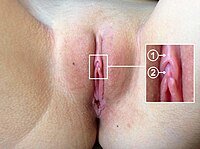
Photo from wikipedia
Because synthetic vascular prostheses perform poorly in small-diameter revascularization, biological vascular substitutes are being developed as an alternative. Although their in vivo results are promising, their production involves long, complex,… Click to show full abstract
Because synthetic vascular prostheses perform poorly in small-diameter revascularization, biological vascular substitutes are being developed as an alternative. Although their in vivo results are promising, their production involves long, complex, and expensive tissue engineering methods. To overcome these limitations, we propose an innovative approach that combines the human amniotic membrane (HAM), which is a widely available and cost-effective biological raw material, with a rapid and robust textile-inspired assembly strategy. Fetal membranes were collected after cesarean deliveries at term. Once isolated by dissection, HAM sheets were cut into ribbons that could be further processed by twisting into threads. Characterization of the HAM yarns (both ribbons and threads) showed that their physical and mechanical properties could be easily tuned. Since our clinical strategy will be to provide an off-the-shelf allogeneic implant, we studied the effects of decellularization and/or gamma sterilization on the histological, mechanical, and biological properties of HAM ribbons. Gamma irradiation of hydrated HAMs, with or without decellularization, did not interfere with the ability of the matrix to support endothelium formation in vitro. Finally, our HAM-based, woven tissue-engineered vascular grafts (TEVGs) exhibited clinically relevant mechanical properties. Thus, this study demonstrates that human, completely biological, allogeneic, small-diameter TEVGs can be produced from HAM, thereby avoiding costly cell culture and bioreactors.
Journal Title: Biofabrication
Year Published: 2022
Link to full text (if available)
Share on Social Media: Sign Up to like & get
recommendations!